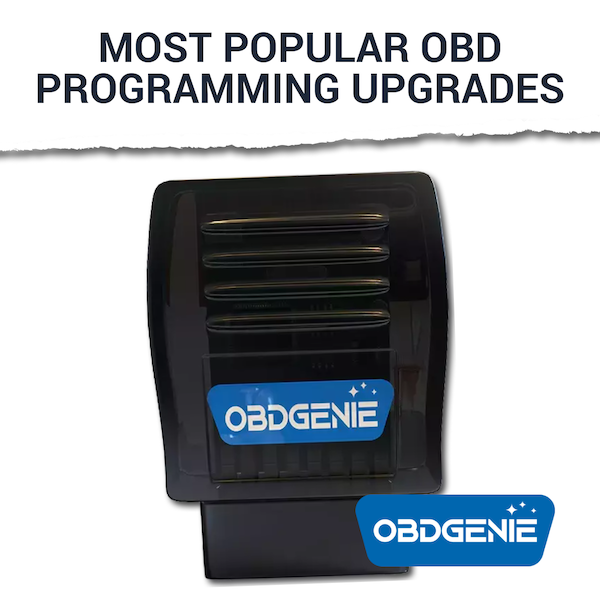
Nov 15 , 2023
Most Popular OBD Programming Upgrades
OBD (On-Board Diagnostics) programming upgrades offer a wide range of benefits, from enhancing engine performance and efficiency to improving driving comfort and convenience. These upgrades involve modifying the car's electronic control units (ECUs) to optimize various parameters and settings.
Safety Upgrades
- Rear View Cameras: While many new cars come equipped with rearview cameras as standard equipment, older vehicles may not have this feature. Fortunately, there is a simple and affordable way to upgrade your car with a rearview camera using an OBD-II scan tool.
- Trailer Brake Controls: If your vehicle doesn't have a factory-installed TBC, you can upgrade to an OBD-enabled TBC, offering several advantages over traditional wired TBCs
- Daytime Running Lights: While DRLs are becoming increasingly common in newer vehicles, older models may not have this feature. Fortunately, upgrading your car with DRLs is a relatively simple and affordable process using an OBD-II scan tool.
Engine Performance Upgrades:
-
ECU Remapping: ECU remapping, also known as chip tuning, is a common OBD programming upgrade that involves altering the ECU's software to optimize fuel injection timing, ignition timing, and other engine control parameters. This can result in significant gains in horsepower, torque, and fuel economy, particularly for turbocharged engines.
-
Turbocharger Boost Enhancement: For vehicles with turbocharged engines, OBD programming can increase boost pressure, leading to a substantial increase in power output. This is achieved by modifying the turbocharger's wastegate control, allowing it to maintain higher boost levels for longer durations.
-
Air-Fuel Mixture Optimization: Adjusting the air-fuel mixture is crucial for optimizing engine performance and fuel efficiency. OBD programming can fine-tune the air-fuel ratio to ensure complete combustion, resulting in better power delivery and reduced fuel consumption.
Transmission Optimization:
-
Shift Points Alteration: Modifying transmission shift points can significantly impact the vehicle's driving characteristics. OBD programming can adjust shift points to allow for quicker gear changes, improving acceleration and responsiveness, especially in performance-oriented vehicles.
-
Torque Management Enhancement: Torque management systems regulate engine torque to maintain traction and prevent wheel spin. OBD programming can optimize torque management parameters to enhance traction and control, particularly in high-performance vehicles and challenging driving conditions.
-
Smoothness and Comfort Enhancements: OBD programming can refine transmission behavior by reducing harsh shifts and minimizing unnecessary gear changes. This can result in a smoother, more comfortable driving experience, especially in urban driving scenarios.
Emission Control Modifications:
-
EGR (Exhaust Gas Recirculation) Valve Adjustments: The EGR valve recirculates a small portion of exhaust gas back into the engine to reduce NOx emissions. OBD programming can modify EGR valve operation to optimize emissions control without compromising performance.
-
DPF (Diesel Particulate Filter) Regeneration Optimization: Diesel vehicles rely on DPFs to trap soot particles. OBD programming can optimize DPF regeneration cycles, ensuring efficient particulate matter removal without compromising performance or fuel economy.
-
Exhaust Gas Temperature Control: Exhaust gas temperature is a critical factor in emission control systems. OBD programming can fine-tune exhaust gas temperature parameters to reduce emissions and improve engine longevity.
Other Performance Enhancements:
-
Launch Control Optimization: Launch control systems are designed to provide maximum acceleration from a standstill. OBD programming can refine launch control parameters, enabling smoother and more effective launches, especially in high-performance vehicles.
-
Throttle Response Enhancement: Throttle response refers to the engine's responsiveness to pedal inputs. OBD programming can adjust throttle response settings to improve sensitivity and responsiveness, resulting in a more engaging driving experience.
-
Speed Limiter Removal: In some cases, OBD programming can remove speed limiters, allowing the vehicle to reach its full potential top speed. This is often done for performance enthusiasts or vehicles used on closed tracks.
Convenience and Customization Features:
-
Door Lock/Unlock Automation: OBD programming can automate door locking and unlocking upon vehicle startup or shutdown, enhancing convenience and security. This can be particularly useful for hands-free entry and exit.
-
Window Roll-Up/Down Automation: OBD programming can enable automatic window roll-up or down upon vehicle startup or shutdown, especially useful in rainy or hot weather conditions. This can be programmed to specific preferences or linked to climate control settings.
-
Customizable Vehicle Settings: OBD programming can allow for the personalization of various vehicle settings, such as lighting configurations, audio preferences, and driving modes. This provides a more tailored driving experience and reflects individual preferences.
It is important to note that OBD programming can be complex if you don't have the proper items needed. If you have purchased an OBD Genie and need help upgrading your vehicle please reach out.
